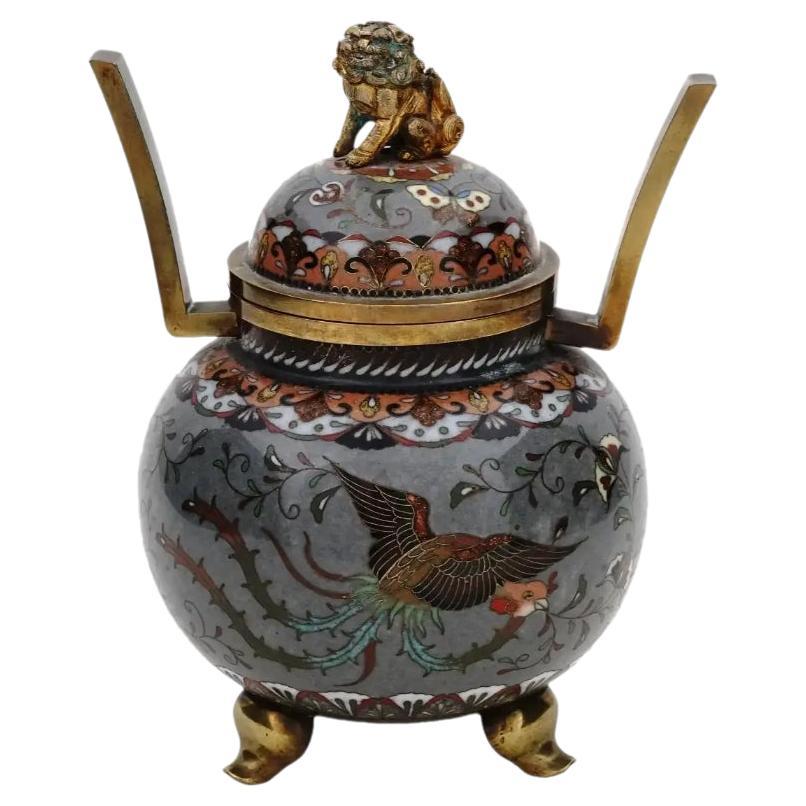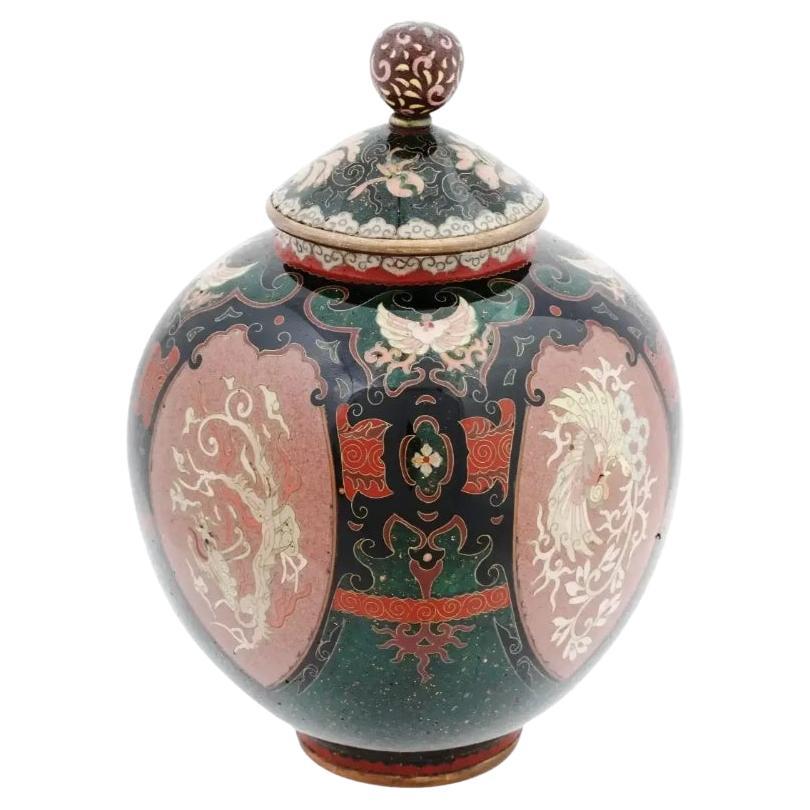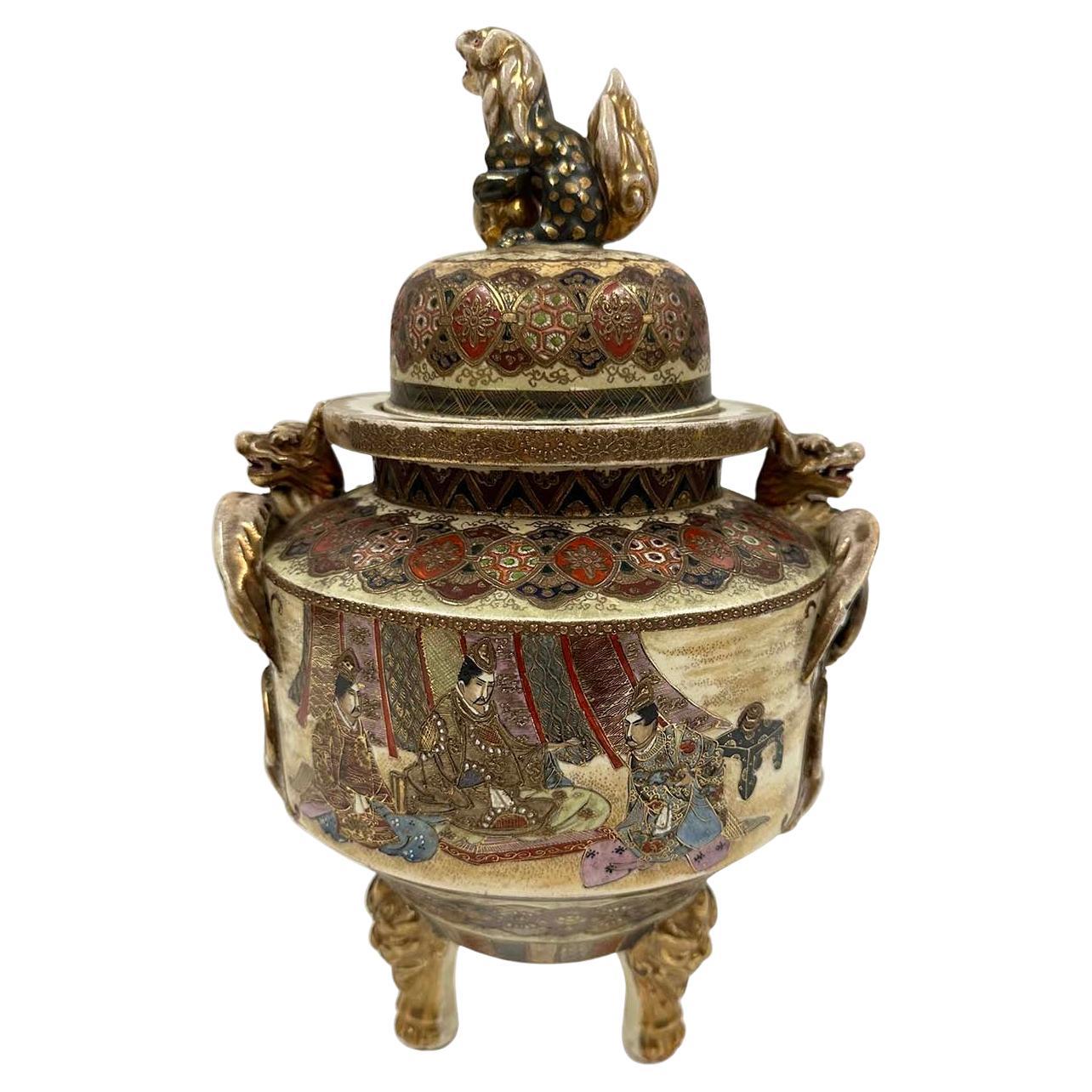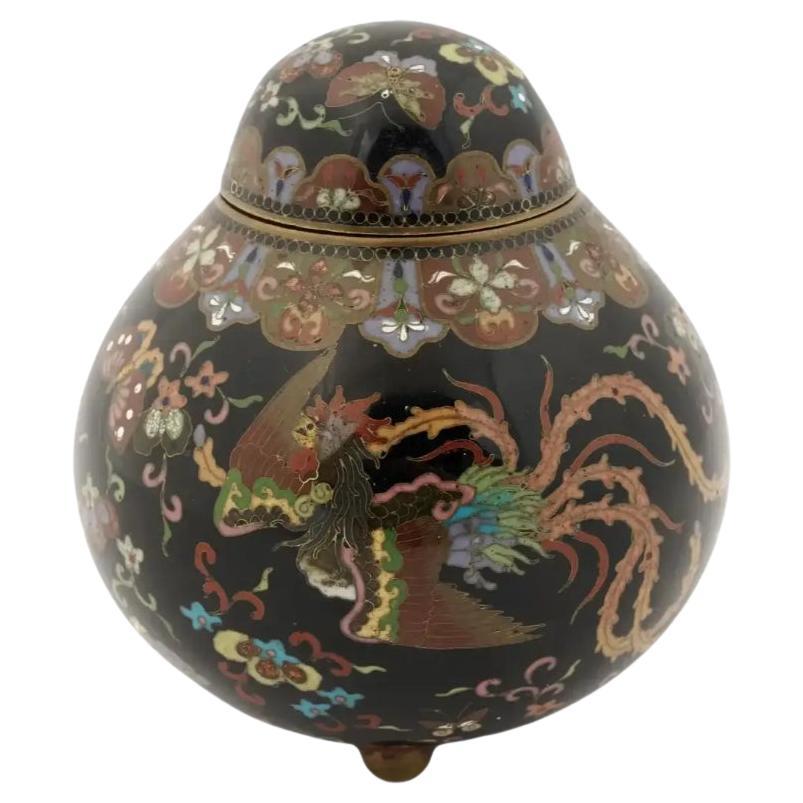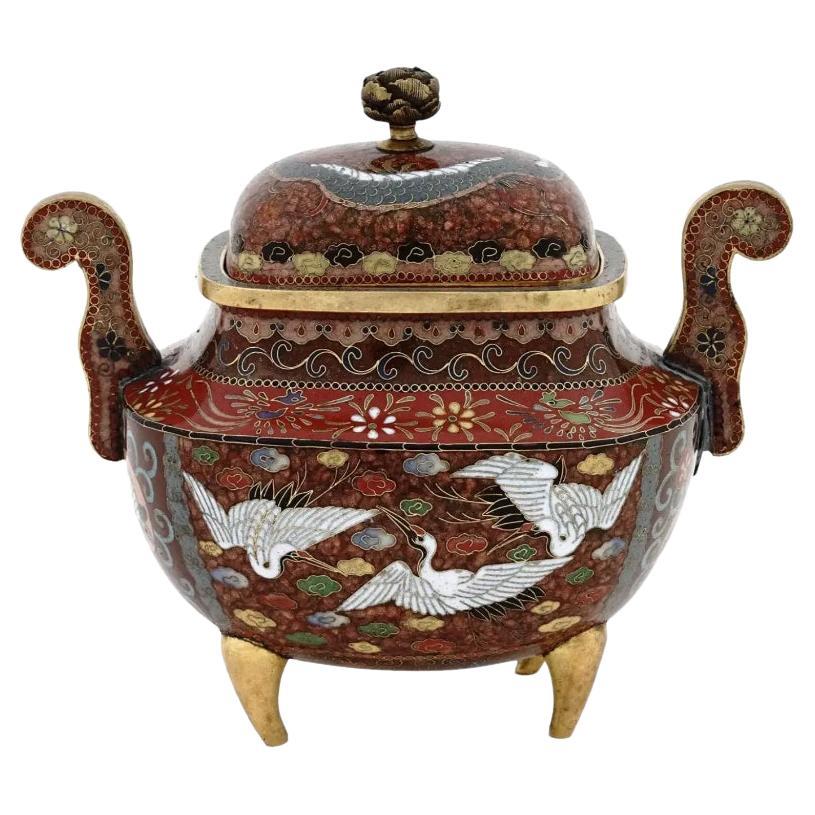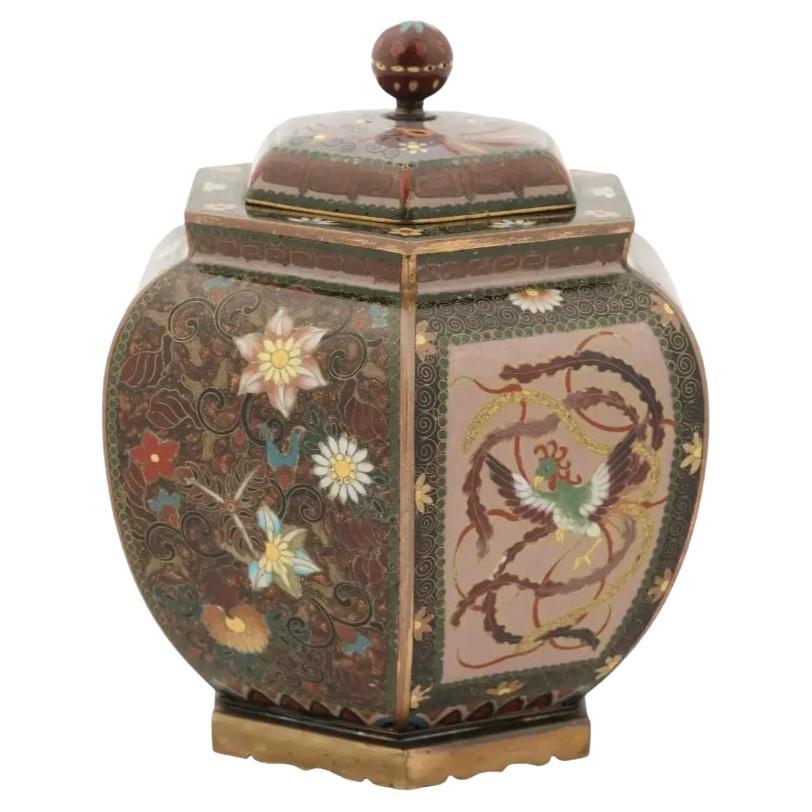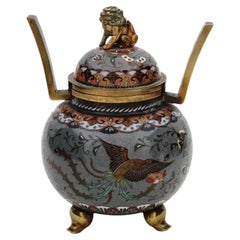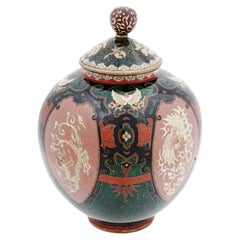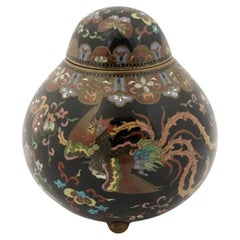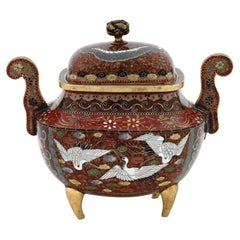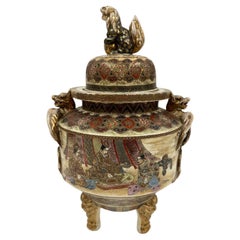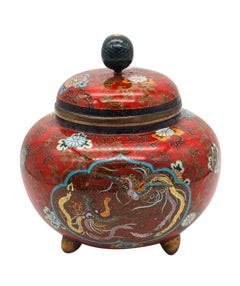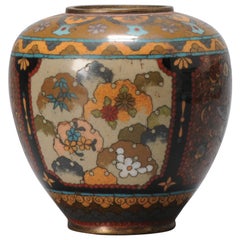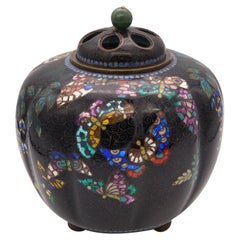Items Similar to Antique Japanese Meiji Goldstone Enamel Censer Koro
Want more images or videos?
Request additional images or videos from the seller
1 of 9
Antique Japanese Meiji Goldstone Enamel Censer Koro
$520
$80035% Off
£397.23
£611.1235% Off
€456.38
€702.1235% Off
CA$743.49
CA$1,143.8335% Off
A$819.15
A$1,260.2335% Off
CHF 424.04
CHF 652.3735% Off
MX$9,862.79
MX$15,173.5235% Off
NOK 5,369.40
NOK 8,260.6135% Off
SEK 5,044.21
SEK 7,760.3235% Off
DKK 3,407.71
DKK 5,242.6435% Off
About the Item
An antique Japanese, late Meiji Era, lidded and footed enamel over brass censer koro or jar. Circa: late 19th century to early 20th century. The sphere form jar is enameled with images of Phoenix birds, surrounded by floral and foliage motifs made in the Cloisonne technique. The lid is decorated with floral, foliage, and geometrical ornaments made in the same technique. The base is adorned with floral, foliage, and geometrical patterns made in the same technique. The ground is inlaid with Goldstone. Unmarked. Antique and Vintage Asian and Oriental Enamel Vases, Table Wares, Home Decor, and Collectibles.
Dimensions: H 3 3/4 in. All measurements are approximate.
Condition
Overall good antique condition. Signs of wear and Age. Refer to photos.
- Dimensions:Height: 3.75 in (9.53 cm)Diameter: 3.75 in (9.53 cm)
- Style:Meiji (Of the Period)
- Materials and Techniques:
- Place of Origin:
- Period:
- Date of Manufacture:Late 19th Century
- Condition:Wear consistent with age and use.
- Seller Location:Long Island City, NY
- Reference Number:1stDibs: LU7386236007132
About the Seller
4.9
Platinum Seller
Premium sellers with a 4.7+ rating and 24-hour response times
1stDibs seller since 2022
104 sales on 1stDibs
Typical response time: <1 hour
- ShippingRetrieving quote...Shipping from: Long Island City, NY
- Return Policy
Authenticity Guarantee
In the unlikely event there’s an issue with an item’s authenticity, contact us within 1 year for a full refund. DetailsMoney-Back Guarantee
If your item is not as described, is damaged in transit, or does not arrive, contact us within 7 days for a full refund. Details24-Hour Cancellation
You have a 24-hour grace period in which to reconsider your purchase, with no questions asked.Vetted Professional Sellers
Our world-class sellers must adhere to strict standards for service and quality, maintaining the integrity of our listings.Price-Match Guarantee
If you find that a seller listed the same item for a lower price elsewhere, we’ll match it.Trusted Global Delivery
Our best-in-class carrier network provides specialized shipping options worldwide, including custom delivery.More From This Seller
View AllJapanese Meiji Era Goldstone Enamel Censer Koro
Located in Long Island City, NY
An antique Japanese Meiji Era tripod enamel metal censer koro. Circa: late 19th century. The sphere form ware is enameled with polychrome medallions with blossoming flowers and butte...
Category
Antique Late 19th Century Japanese Meiji Jars
Materials
Enamel
Antique Japanese Cloisonne Meiji Goldstone Enamel Censer Koro with Dragons
Located in Long Island City, NY
An antique Japanese, late Meiji Era, lidded and footed enamel over brass censer koro or jar. Circa: late 19th century to early 20th century. The sphere form jar is enameled with meda...
Category
Antique Late 19th Century Japanese Meiji Jars
Materials
Enamel, Brass
Antique Japanese Cloisonne Gold Stone Ginger Jar Butterflies and Phoenix Birds
Located in Long Island City, NY
An antique Japanese Meiji era tripod and covered enamel gilt metal ginger jar.
The jar is enameled with polychrome images of a Phoenix bird, butterflies and blossoming flowers and f...
Category
Antique Mid-19th Century Japanese Jars
Materials
Enamel
Antique Meiji Japanese Cloisonne Gold Stone Enamel Covered Jar with Dragon and C
Located in Long Island City, NY
An antique Japanese, late Meiji era, covered enamel over brass pot or box. The body of the ware is enameled with polychrome images of cranes, medallions with blossoming flowers and b...
Category
Antique Late 19th Century Japanese Meiji Planters, Cachepots and Jardini...
Materials
Brass, Enamel
Antique Meiji Japanese Cloisonne Goldstone Lidded Jar Phoenix Birds and Flowers
Located in Long Island City, NY
Antique Meiji Japanese Cloisonne Goldstone Lidded Jar Phoenix Birds and Flowers
An antique Japanese Meiji era covered enamel metal jar.
The hexagonal shaped jar is enameled with polychrome medallion images of Phoenix birds, floral, foliage, and swirl motifs made in the Cloisonne technique. The ground is inlaid with a Gold stone. The neck is adorned with a traditional Greek...
Category
Antique Late 19th Century Japanese Jars
Materials
Enamel
Antique Japanese Meiji Period Round Cloisonne Covered Jar
Located in Long Island City, NY
An antique Japanese Meiji period round cloisonne covered jar showcasing the exquisite artistry and craftsmanship of the era. This jar is adorned w...
Category
Early 20th Century Japanese Meiji Jars
Materials
Enamel
You May Also Like
Antique Japanese Meiji Period Satsuma Incense Burner Censer
Located in Pomona, CA
UP for you consideration is a beautiful antique Meiji period Japanese gold gilt satsuma incense burner marked/signed by Kinkozan. Very fine hand...
Category
Early 20th Century Japanese Chinese Export Urns
Materials
Porcelain
JAPAN IMPERIAL 1900 Meiji Period Tripode Koro Censer In Cloisonné Enamel With
Located in Miami, FL
Japanese tripod Koro from the Meiji Period (1868-1912).
This is a rare and beautiful antique koro censer, created in the imperial Japan during the Meiji period (1868-1912), circa 1900. It was carefully crafted in solid bronze and copper with silver wires and embellished with applications of polychromatic Cloisonné enamels and aventurine. The designs depict organics and natural motifs such mythological animals and flowers.
The Chrysanthemum Symbol
In Imperial Japan, the chrysanthemum (Kiku) was a potent symbol of the imperial family and the emperor himself, representing longevity, royalty, and divine power. The 16-petaled chrysanthemum is the Imperial Seal and crest, found on passports, coins, and the Chrysanthemum Throne. This association dates back to the Kamakura period (1185–1333), particularly with Emperor Go-Toba's fondness for the flower, establishing its link to imperial authority and lineage. The connection between the chrysanthemum and the imperial family began when Emperor Go-Toba adopted it as a personal emblem, aligning it with the strength and refinement of the emperor's rule. During the Meiji Period, the 16-petaled chrysanthemum crest, solidifying the association with the imperial family, was established during this time.
The Meiji Imperial Period
This is an era of Japanese history that extended from October 23, 1868 to July 30, 1912.The Meiji era was the first half of the Empire of Japan, when the Japanese people moved from being an isolated feudal society at risk of colonization by Western powers to the new paradigm of a modern, industrialized nation state and emergent great power, influenced by Western scientific, technological, philosophical, political, legal, and aesthetic ideas. As a result of such wholesale adoption of radically different ideas, the changes to Japan were profound, and affected its social structure, internal politics, economy, military, and foreign relations. The period corresponded to the reign of Emperor Meiji. It was preceded by the Keiō era and was succeeded by the Taishō era, upon the accession of Emperor Taishō.
Country: Imperial Japan.
Period: Meiji, 1890-1910.
Technique: Silver Wire Cloisonné over copper and bronze.
Weight: 416.80 Grams, (0.417 Kg).
Measurements:118 mm by 115 mm (4.65 x 4.52 Inches).
Koro
This term refers to a Japanese censer, incense burner, perfume burner or pastille burner is a vessel made for burning incense or perfume in some solid form. They vary greatly in size, form, and material of construction, and have been in use since ancient times throughout the world. They may consist of simple earthenware bowls or fire pots to intricately carved silver or gold vessels, small tabletop objects a few centimeters tall to as many as several meters high. Many designs use openwork to allow a flow of air. In many cultures, burning incense has spiritual and religious connotations, and this influences the design and decoration of the censer.
Cloisonné
This is an enameling technique in which the pattern is formed by wires soldered to the surface of the object to be decorated, which is usually made from copper, forming cells or cloisons, each of which holds a single colour of enamel paste which is then fired, and ground and polished. The champleve technique also uses an enameling technique, but the cells are formed by carving into the surface of the object, or in the casting. The cloisonne technique has been in use since the 12th century BC in the west, but the technique did not reach China until the 13th or 14th century. It became popular in China in the 18th century. Initially bronze or brass bodies were used, and in the 19th century copper, at which time the quality of the items produced began to decline. Chinese cloisonné is the best-known enamel cloisonné, though the Japanese produced large quantities from the mid-19th century, of very high technical quality. In the west the cloisonne technique was revived in the mid-19th century following imports from China, and its use continued in the Art Nouveau and Art Deco periods.
Condition: Basically, is in great antique condition, near mint, with insignificant and minimal usage, in great condition. All parts are secured in the settings. This Japanese Meiji Koro...
Category
Antique Early 1900s Japanese Meiji Metalwork
Materials
Silver, Bronze, Copper, Enamel
A Small Vase with Incense Brown Cloisonné Enamel Meiji Era, 1868-1912
Located in Amsterdam, Noord Holland
A Small Vase with Incense Brown Cloisonné Enamel Meiji Era, 1868-1912
Top quality piece, lid is missing.
Meiji era (1868-1912), 19th century.
Additional information:
Material: Bron...
Category
Antique 19th Century Japanese Vases
Materials
Bronze
$747 Sale Price
20% Off
Japan 1890 Meiji Period Bronze Koro Censer in Cloisonne Enamel with Jade Lid
Located in Miami, FL
Japanese Koro from the Meiji Period (1868-1912).
Beautiful antique ten sides fluted koro censer, created in Japan during the Meiji period (1868-1912), ci...
Category
Antique 1890s Japanese Meiji Metalwork
Materials
Jade, Gold, Silver, Bronze, Enamel
Enamel Bronze Vase Censer in the Shape of a Bell Bird, Japan, Edo or Meiji
Located in Amsterdam, Noord Holland
Nicely made artifact.
Stand not included.
Condition:
Overall condition perfect. Size: 295mm
Period:
18th century
19th century Edo Period (1603–1867).
Category
Antique 19th Century Japanese Meiji Ceramics
Materials
Bronze
$1,185 Sale Price
20% Off
Japanese Satsuma Incense Burner, Koro, with Silver Lid, Meiji Period, Japan
Located in Austin, TX
A fantastic Japanese Satsuma incense burner, koro, with phoenix and brocade designs and a silver lid, Meiji Period, late 19th century, Japan.
The cens...
Category
Antique 1890s Japanese Meiji Ceramics
Materials
Silver
More Ways To Browse
Japan Jar
Enameled Brass Vase
Japanese Antique Jar
Japanese Brass Vase
Cloisonne Lidded
Brass Censer
Blue White Chinese Lidded
19th Century Chinese Blue White Jar
Candy Jar
Delft Blue Jar
Legend Of Asia
Lidded Chinese Ceramic
Powder Jar
19th Century Ginger Jar
Baluster Jar
Chinese Blue And White Temple Jar
Dragon Jar
French Pharmacy
